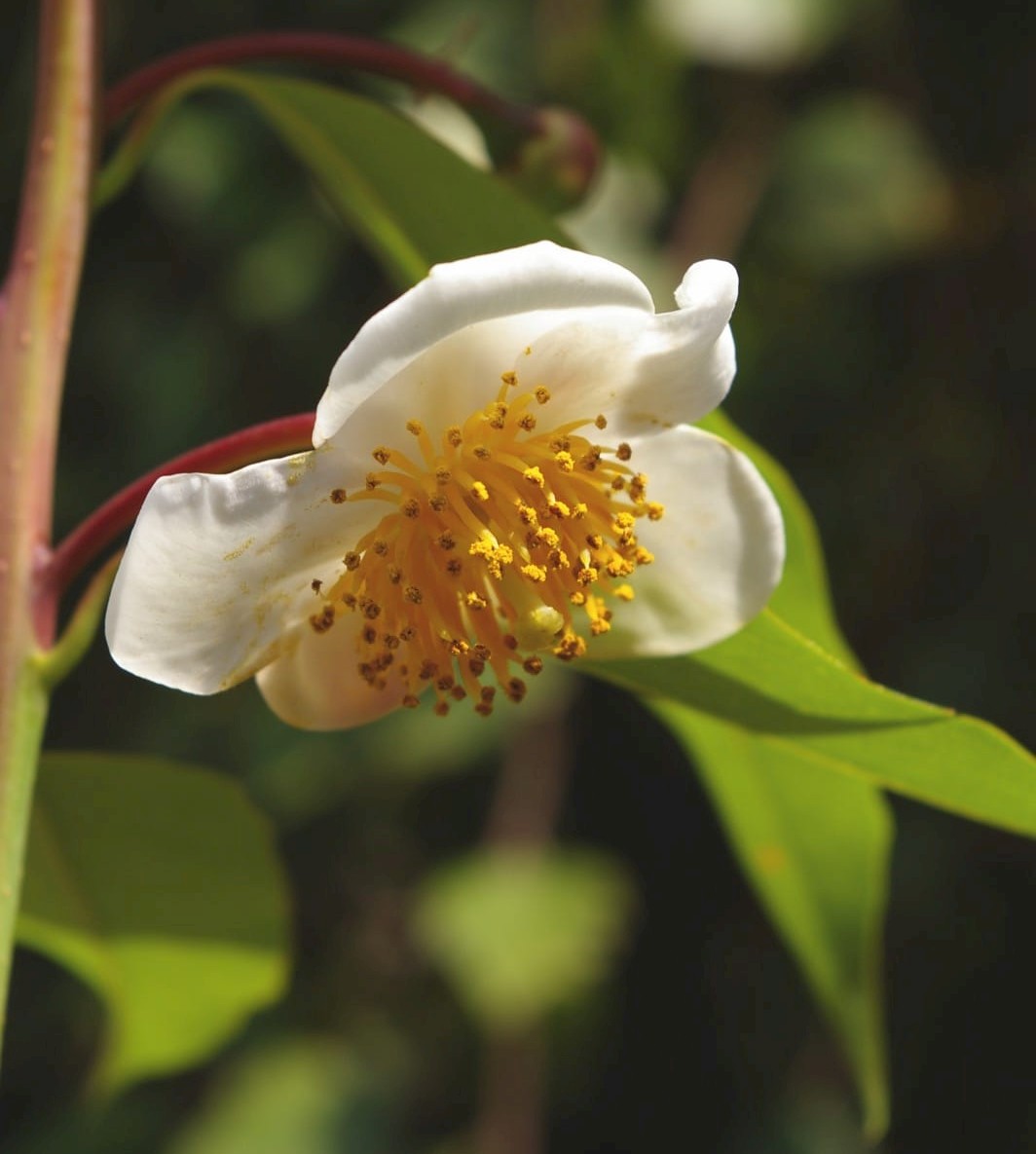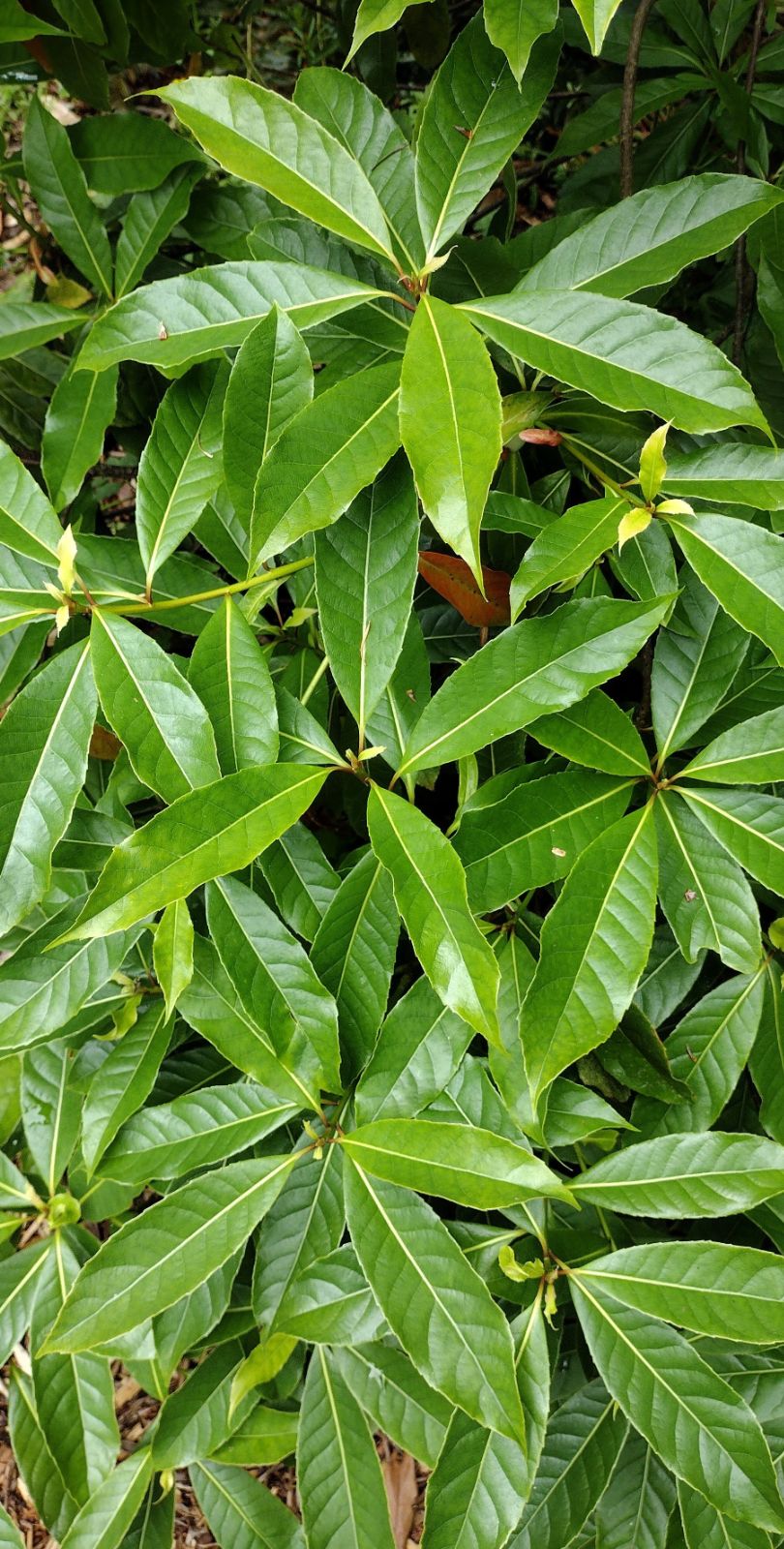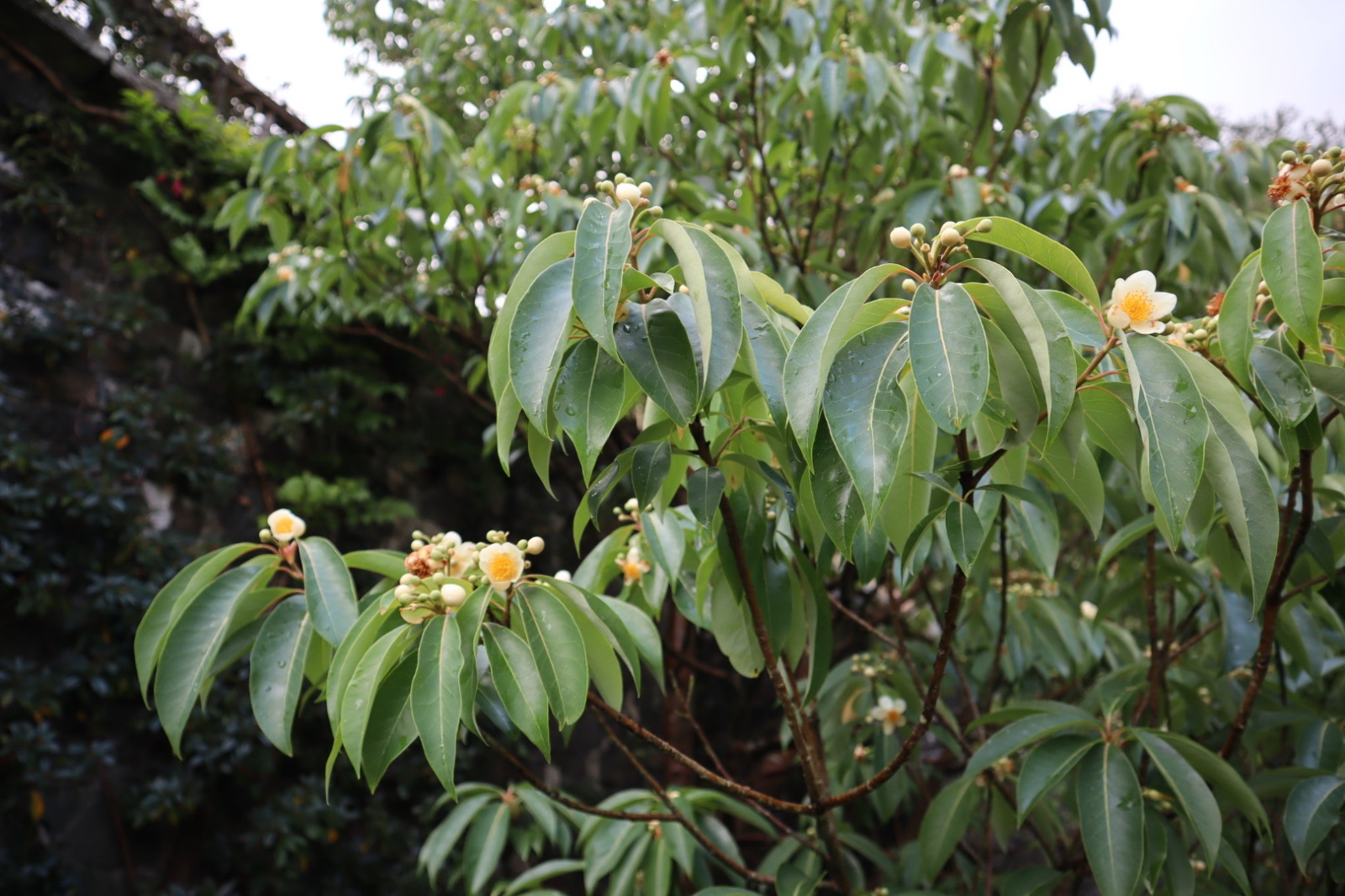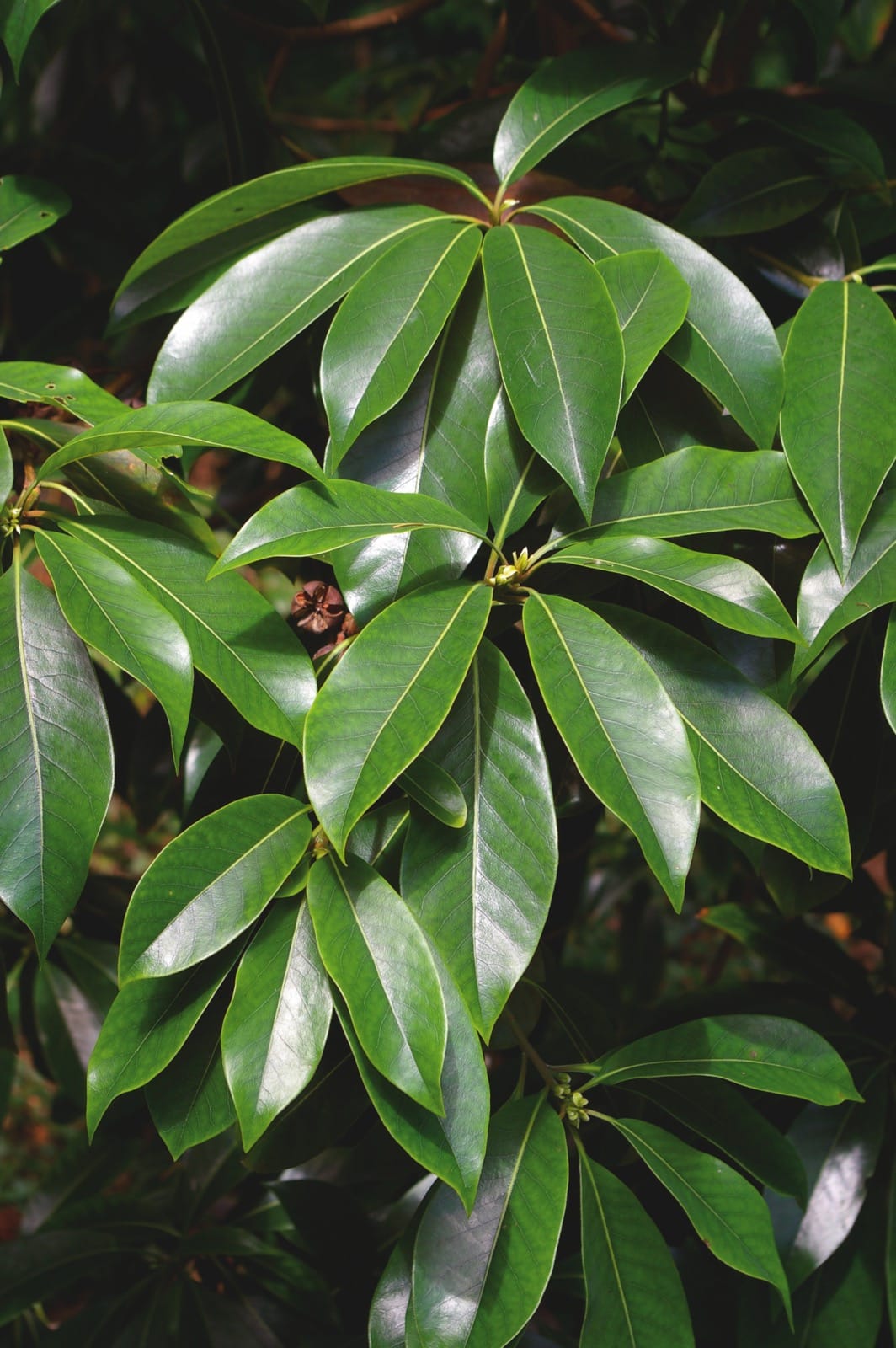Schima
Credits
Article from Bean's Trees and Shrubs Hardy in the British Isles
Article from New Trees by John Grimshaw & Ross Bayton
Recommended citation
'Schima' from the website Trees and Shrubs Online (treesandshrubsonline.
Family
- Theaceae
Schima comprises anywhere between one and thirty species of evergreen trees (rarely shrubs), distributed from the Himalaya through southeastern Asia to New Guinea. The branchlets are covered with white lenticels, while the buds are covered in silky hairs. The leaves are entire, alternate, spirally arranged, and entire to crenate or serrate. Schima flowers are hermaphrodite, axillary and solitary, or rarely three to five flowers are crowded along a short raceme. The flowers are subtended by two or more caducous bracteoles, and have five sepals, basally fused and persistent, five white petals, also basally fused, and numerous stamens. The fruit is a woody, globose or subglobose capsule, which splits for half its length into (four to) five (to six) segments; a stout, central column remains. The seeds are small and kidney-shaped, with a narrow marginal wing (Keng 1994, Stevens et al. 2004, Ming & Bartholomew 2007).
Schima species are extremely variable and can be difficult to distinguish. For this reason, Bloembergen (1952) amalgamated all of them into one species, S. wallichii (DC.) Korth. More recent opinions (Prince & Parks 2001, Ming & Bartholomew 2007) suggest that the genus contains numerous species; the truth is probably somewhere in between. The consequence, especially of Bloembergen’s work, which became widely adopted (see, for example, Bean 1981b), is that nomenclature within Schima is a mess. The shoehorning of everything into S. wallichii not only obscured the range of variation in the genus, but resulted in lengthy trinomials (S. wallichii (DC.) Korth. subsp. noronhae (Bl.) Bloembergen var. superba (Gardner & Champ.) Bloembergen, for example) that were very unwieldy and sometimes fragmented into various dubious combinations. The problem is that Schima is both rather uniform in general appearance across the genus and rather variable within species – making the fine points of recognition required by the key in Flora of China, for example, difficult to use.
The recent wave of plant-hunting effort in the Sino-Himalaya has resulted in a much wider diversity of Schima in cultivation than ever before, but a rather opaque veil is drawn over them by these nomenclatural and identification difficulties, and ‘Schima sp.’ is how most are noted in garden lists. In view of the difficulties and general confusion associated with the genus it is important that specimens in arboreta are reviewed and re-identified, so far as this is possible. It will probably be necessary to wait for flowers. The descriptions below are provided to help with the identification of plants under various names frequently seen in literature and on labels.
A name that has been in circulation for some time is ‘S. yunnanensis’. This appears to have become attached to material collected in 1984 as SBEC 0079, on the Sino-British Expedition to Cangshan, Yunnan, but has no botanical validity. Detective work by John David (David 2007) suggests that the material in question is S. argentea, a species first introduced by George Forrest and apparently persisting in cultivation from his gathering F 15029 made in 1917. With strongly glaucous undersides to its leaves, S. argentea is a handsome plant. Owing to the taxonomic difficulties now associated with the name S. wallichii, it is difficult to be certain whether this species as narrowly defined is in cultivation. It is found across a wide range in Asia, but is perhaps best known from Nepal (Lancaster 1981, Polunin & Stainton 1984). Seed was collected from Nepalese trees in 1993 by Bill McNamara, but did not germinate (McNamara 2007b). In the David C. Lam Asian Garden in Vancouver there is a tree identified as S. sericans (Hand.-Mazz.) T.L. Ming, grown from PW 107A. This flowered first in September 2006 and has made a very attractive specimen, with abundant, rounded, fragrant flowers (Mosquin 2006). Trees labelled S. noronhae are in cultivation, but with the persistence of Bloembergian nomenclature it is by no means clear if these represent the ‘real thing’, S. noronhae Reinw. ex Blume, a principally tropical species. Hudson (2004) notes that the trees have ‘superior’ flowers, produced in clusters from the terminal axils of each shoot.
Whatever name is attached to them, Schima are all horticulturally very interesting, having handsome evergreen foliage that may flush reddish. The fragrant, white ‘fried-egg’ flowers containing a big boss of stamens are often produced through the autumn and winter months as well as in spring. (It should, however, be noted that cultivated plants may flower at different seasons to those in the wild.) With the development of the hybrid genus ×Schimlinia (see p. 784), Schima has taken on even more significance. They need a warm or at least mild climate with ample moisture and humidity to do well, so in our area they are effectively confined to the western coastal fringes of Europe and the Pacific Northwest; they also thrive in the southeastern United States (Hogan 2008). Light open woodland conditions are the most suitable, where young specimens can be planted in light understorey and allowed to quest for the canopy. Like the evergreen magnolias, they have the potential to become very substantial trees when mature. Johnson (2007) records (under the usual miscellany of names and combinations) several specimens in western Britain that are over 10 m tall. The largest of all is a ‘S. wallichii var. khasiana’ measured at 20 m (70 cm dbh) at Trewithen, Cornwall in 2004; a specimen with this name at Logan House, Dumfries & Galloway was 11 m tall in 1993. As with other members of the Theaceae, Schima species require acidic soil. Propagation is either from seed, sown as fresh as possible, and with a cool stratification period, or from cuttings taken in late summer or early autumn (Hogan 2008). Cutting-raised plants can flower well when still small. In locations with marginal conditions it may be best to allow plants to build up some wood in a pot for a few years, but in favourable areas they succeed if planted out while young (McNamara 2007b).
Bean’s Trees and Shrubs
Schima
A genus of evergreen trees and shrubs, in which some fifteen species have been described, reduced to one in the revision referred to below. They are natives of the subtropical and warm temperate regions of S.E. Asia, but extending into the E. Himalaya and S.W. China (as far north as Mt Omei in W. Szechwan). Leaves alternate, entire or toothed. Flowers white, showy, borne singly on distinct pedicels in the upper leaf-axils; pedicels with two opposite bracteoles. Sepals five, much smaller than the petals. Petals five, united at the base. Stamens numerous. Style one. Fruit a globose woody capsule flattened at the apex. Seeds flat, with a narrow wing at one side. Allied to Gordonia, but in that genus the capsule is oblong and the seeds are winged at one end.
A revision of Schima by S. Bloembergen was published in Reinwardtia Vol. 2 (1952), pp. 133–83.
The type-species of the genus is S. noronhae Reinwardt ex Blume of Java and S.E. Asia, but the first species to be described (in the genus Gordonia) was S. wallichii (DC.) Korthals, which, in the narrow sense, ranges from the eastern Himalaya to Yunnan. In the revision cited above, only this species is recognised, with two subspecies – subsp. wallichii and subsp. noronhae (Bl.) Bloembergen. Of the species treated here, S. argentea is in this revision sunk in S. wallichii subsp. noronhae var. superba (Gardner & Champion) Bloembergen, and S. khasiana becomes S. wallichii subsp. wallichii var. khasiana (Dyer) Bloembergen.




